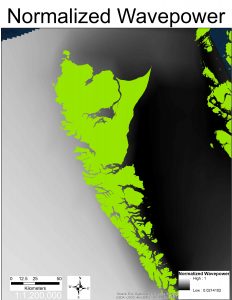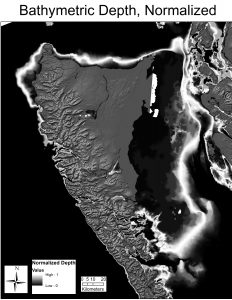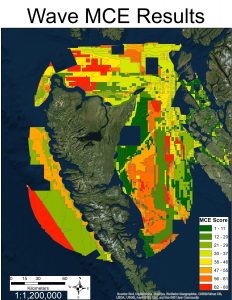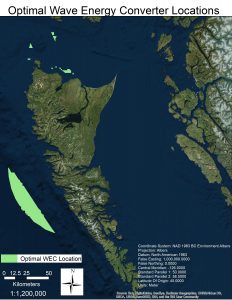Wave Energy:
The factors included for the wave energy MCE included:
- Distance from transmission lines
- Advised against areas
The distance from transmission lines and advised against areas layers did not need to be modified for the wave energy MCE, the same normalized layers were used.
- Wave power
The average annual wave power layer (acquired from BCMCA) was normalized using the raster calculator tool by dividing the wave power raster by the maximum value in order to create a new normalized wave power layer.
- Bathymetric depth
The WECs we are considering operate optimally at a depth of 80 meters. However, it can operate at depths of around 30 meters to depths greater than 100 meters, but not optimally. For that reason, the bathymetric depth raster layer was normalized using a gaussian fuzzy membership function with spread equal to 0.001 and midpoint set to 80 meter depth. Additionally, using the Set Null tool, we set depth values of 0-20 meters in the bathymetric depth raster layer equal to “NoData” so that they would be excluded from our normalized bathymetric depth layer.
When determining the factors’ weights with through an AHP, we felt as though the Advised Against areas layer was the most important factor. This factor needed to be assigned the highest weight because a renewable energy project on Haida Gwaii would have a high chance of getting canceled or experiencing significant public opposition if the project was developed within one of these areas. Identifying areas of relatively high wave power was determined to be the second most important factor for our MCE. Bathymetric depth and distance from transmission lines were both given relatively low scores through the AHP because they represent factors that act to marginally decrease the total energy produced or add extra cost to the project developer. These two factors need to be considered, however they do not have a high likelihood of stopping a project from being developed altogether if optimal conditions are not reached.
| Wave MCE Factor | AHP Score / Weight |
| Advised Against Areas | 0.4725 |
| Wave Power | 0.3505 |
| Bathymetric Depth | 0.1153 |
| Distance From Transmission Lines | 0.0618 |
After overlaying these four normalized factors with their associated weights, we proceeded to convert the MCE raster layer to a polygon layer so that we could erase the constraints from our MCE results. As described in the Wind MCE Methodology, we used the Times tool to multiply our MCE raster values by 100 and then converted the raster to integer in order to convert the raster to a vector polygon layer. Areas that scored greater than or equal to 66 were the most optimal areas for wave energy converter arrays, and can be seen below.




